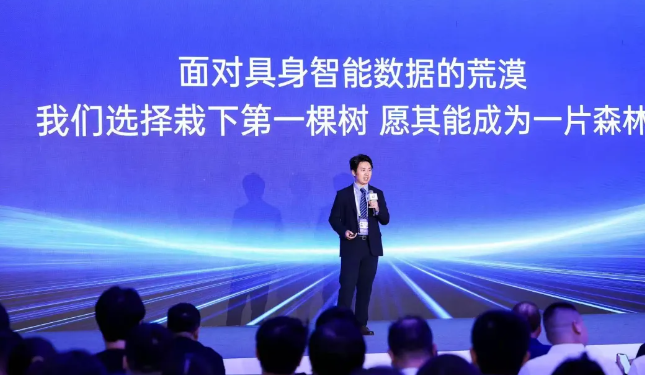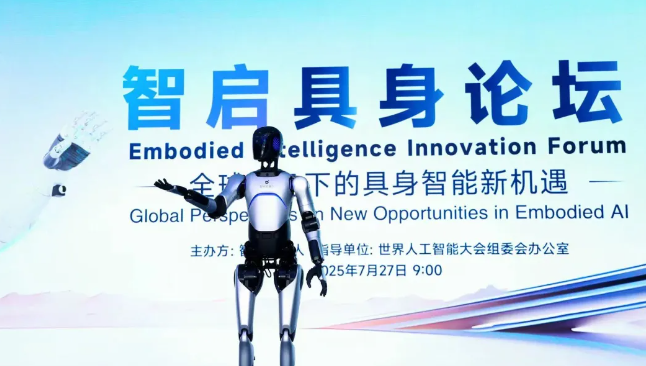Two star companies in embodied intelligence: Yushu to the left, Zhiyuan to the right.
There's a saying that Yushu aspires to be the "DJI" of land, and Zhiyuan to be the "Huawei" of embodied intelligence. Zhiyuan founder Peng Zhihui, in an interview with Jiazi Guangnian in June of this year, stated that this analogy holds some truth, stating that Huawei exemplifies a full-stack technology ecosystem.
At the recent WAIC2025 in Shanghai, Zhiyuan Robotics took another step toward this vision: Zhiyuan Partner Yao Maoqing, on behalf of Zhiyuan Robotics, launched "Genie Envisioner" (hereinafter referred to as "GE"), the industry's first open-source world model platform for real-world dual-arm robots.

The GE platform integrates three core capabilities: prediction, control, and evaluation. It provides an end-to-end, integrated solution for robots, from "seeing" to "acting," enabling them to rehearse in digital space before deploying.
In other words, just like soldiers undergoing simulated training before heading into battle, it allows robots to conduct countless drills in a highly simulated digital space before entering the real world, significantly reducing the risks and trial-and-error costs of real-world deployment.
The open-source nature of the GE platform is a key component of Zhiyuan's embodied intelligence strategy. It goes beyond simple technology sharing; it serves as the foundation for building an embodied intelligence ecosystem.
For developers and researchers in the global embodied intelligence field, GE offers a powerful and easy-to-use capability chain, enabling more people to participate in the development and scenario exploration of complex dual-arm robot applications, greatly accelerating innovation and iteration.
If the platform continues to attract more developers, Zhiyuan, through the GE platform, has the potential to become a core operating system developer for the embodied intelligence field, similar to Android, and gain a leading voice in the ecosystem.
From the data perspective, open source will generate massive and diverse simulation and real-world interaction data, which will feed back into the GE platform itself, making its predictions more accurate and its generalization capabilities stronger, forming a self-reinforcing closed loop.

This crucial step also clearly confirms Peng Zhihui's recognition of Zhiyuan's analogy to "Huawei in the field of embodied intelligence."
Huawei is renowned for its comprehensive technology stack (chips, operating systems, network equipment, and terminals) and robust ecosystem-building capabilities. Zhiyuan's development path aligns well with this approach:
GE, as its core open-source world model platform, connects perception, cognition, and action, serving as an operating system for embodied intelligence, comparable to Huawei's HarmonyOS.
In terms of ecosystem development, through the GE platform, Zhiyuan is actively attracting global developers to build applications on its platform, fostering an embodied intelligence application ecosystem.
Zhiyuan's proprietary high-performance joint motors are the underlying core technology for its robots, much like Huawei's in-house Kirin chips.
While much of the industry's attention is focused on bipedal humanoid robots, Zhiyuan chose a dual-arm robot as the first application for the GE platform, demonstrating its pragmatic approach.
Dual-arm collaborative operation currently has clear demand and real-world applications in industrial manufacturing, precision assembly, logistics sorting, and other scenarios, directly impacting productivity. The GE platform prioritizes these high-value, achievable, and complex operational issues, demonstrating a clear understanding of how technology can serve the industry.
Currently, numerous players are emerging in the embodied intelligence field, and their respective paths have already shown significant differences.
On the eve of WAIC 2025, Yushu Technology released its new bipedal humanoid robot, the R1, with a starting price of 39,900 yuan, pushing the price of humanoid robots to a new high. This makes humanoid robots with professional athletic capabilities accessible to ordinary developers at a lower barrier to entry—a testament to the outstanding product and supply chain efficiency of companies like DJI.
Looking overseas, Tesla's Optimus Prime robot, leveraging its strong AI capabilities and automotive manufacturing background, adopts a vertically integrated approach combining software and hardware, offering enormous potential but a relatively closed ecosystem.
Zhiyuan also possesses exceptional characteristics. Leveraging its proprietary hardware (joints and body), open-source platform (GE World Model), and ecosystem development, it avoids competing with companies like Yushu Technology in pure athletic capabilities while also distinguishing itself from Tesla's closed system, demonstrating a clear and differentiated strategic positioning.
In addition to the GE platform, AgiBot has also created the world's largest dataset, AgiBot World, through its own professional data acquisition factory and has now opened it to the public. Yao Maoqing stated, "Faced with a vast desert of embodied intelligence data, we've chosen to plant the first tree, hoping it will grow into a forest."
The launch of the GE platform marks a strategically significant step for AgiBot in its embodied intelligence journey. It's more than just a technological product; it's a blueprint for an ecosystem.
With openness at its core, AgiBot aspires to become a shaper of the ecosystem in the embodied intelligence era, much like Huawei has done in the communications and smart device sectors.
"The world model allows some robots to imagine, not just counting electronic sheep in a dream, but to foresee the future," Yao Maoqing said.
This paper is from Ulink Media, Shenzhen, China, the organizer of IOTE EXPO (IoT Expo in China)


















